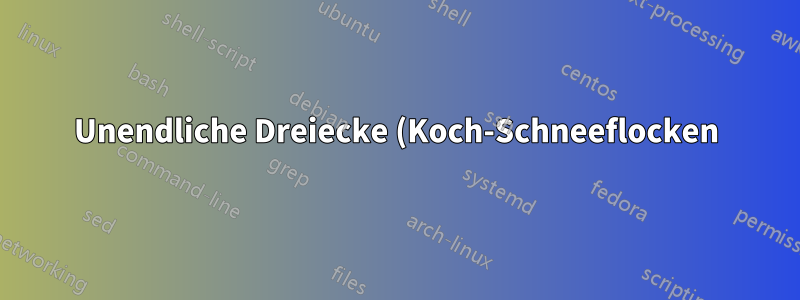%20und%20Kombination%20zu%20einer%20Linie.png)
Ich habe versucht, das folgende Bild zu erzeugen:
Ich habe jedenfalls versucht, eine Möglichkeit zu finden, dies zu erstellen und habe diesen Code von einem anderen Benutzer gefunden, also habe ich ihn wie folgt manipuliert:
\documentclass[11pt]{scrartcl}
\usepackage[utf8]{inputenc}
\usepackage{asy}
\begin{document}
\begin{asy}
size(100);
pair t = dir(150);
int d = 0;
pair[] points = {t};
void forward(real dist) {
pair oldT = t;
t = oldT + dist*dir(d);
draw(oldT--t);
pair[] p = {t};
points.append(p);
}
void left(int angle) {
d = d + angle;
}
int[] angles = {60,-120,60,0};
void koch(int order, real size) {
if (order == 0) {
forward(size);
}
else {
for (int i = 0; i < angles.length; i += 1) {
koch(order-1, size/3);
left(angles[i]);
}
}
}
koch(0,sqrt(3));
void drawArray(pair[] arr) {
for (int i = 1; i<arr.length; i+=1) {
if (i == 1) {
draw(arr[0]--arr[1]);
}
else {
draw(arr[i-1]--arr[i]);
}
}
}
pair[] pointsLeft = new pair[points.length];
pair[] pointsRight = new pair[points.length];
for (int i = 0; i < points.length; i+=1) {
pointsLeft[i] = points[i] * dir(120);
pointsRight[i] = points[i] * dir(-120);
}
drawArray(pointsLeft);
drawArray(pointsRight);
\end{asy}
\begin{asy}
size(100);
pair t = dir(150);
int d = 0;
pair[] points = {t};
void forward(real dist) {
pair oldT = t;
t = oldT + dist*dir(d);
draw(oldT--t);
pair[] p = {t};
points.append(p);
}
void left(int angle) {
d = d + angle;
}
int[] angles = {60,-120,60,0};
void koch(int order, real size) {
if (order == 0) {
forward(size);
}
else {
for (int i = 0; i < angles.length; i += 1) {
koch(order-1, size/3);
left(angles[i]);
}
}
}
koch(1,sqrt(3));
void drawArray(pair[] arr) {
for (int i = 1; i<arr.length; i+=1) {
if (i == 1) {
draw(arr[0]--arr[1]);
}
else {
draw(arr[i-1]--arr[i]);
}
}
}
pair[] pointsLeft = new pair[points.length];
pair[] pointsRight = new pair[points.length];
for (int i = 0; i < points.length; i+=1) {
pointsLeft[i] = points[i] * dir(120);
pointsRight[i] = points[i] * dir(-120);
}
drawArray(pointsLeft);
drawArray(pointsRight);
\end{asy}
\begin{asy}
size(100);
pair t = dir(150);
int d = 0;
pair[] points = {t};
void forward(real dist) {
pair oldT = t;
t = oldT + dist*dir(d);
draw(oldT--t);
pair[] p = {t};
points.append(p);
}
void left(int angle) {
d = d + angle;
}
int[] angles = {60,-120,60,0};
void koch(int order, real size) {
if (order == 0) {
forward(size);
}
else {
for (int i = 0; i < angles.length; i += 1) {
koch(order-1, size/3);
left(angles[i]);
}
}
}
koch(2,sqrt(3));
void drawArray(pair[] arr) {
for (int i = 1; i<arr.length; i+=1) {
if (i == 1) {
draw(arr[0]--arr[1]);
}
else {
draw(arr[i-1]--arr[i]);
}
}
}
pair[] pointsLeft = new pair[points.length];
pair[] pointsRight = new pair[points.length];
for (int i = 0; i < points.length; i+=1) {
pointsLeft[i] = points[i] * dir(120);
pointsRight[i] = points[i] * dir(-120);
}
drawArray(pointsLeft);
drawArray(pointsRight);
\end{asy}
\begin{document}
Ich habe dies erhalten (der rosa/orange Hintergrund stammt von einem Textfeld):
Ich würde gerne wissen, wie man diese drei Figuren zu einer Linie mit angemessenem Abstand kombiniert, und das $P_n$ darunter sowie die $\cdots$ rechts, obwohl das nicht so notwendig ist. Danke!
Antwort1
Noch eine Alternative:
// Koch.asy
// run `asy Koch.asy`
// to get a standalone `Koch.pdf`
settings.tex="pdflatex";
import fontsize;defaultpen(fontsize(7.5pt));
texpreamble("\usepackage{lmodern}"
+"\usepackage{amsmath}"
+"\usepackage{amsfonts}"
+"\usepackage{amssymb}"
);
guide gKoch(int n, pair A, pair B){
guide g;
pair C,D,E;
if(n>0){
C=A+(B-A)/3; E=B+(A-B)/3;
D=rotate(-60,C)*E;
g=gKoch(n-1,A,C)--gKoch(n-1,C,D)--gKoch(n-1,D,E)--gKoch(n-1,E,B);
}else{
g=A--B;
}
return g;
}
guide KochFlake(int n, pair A, pair B, pair C){
return gKoch(n,A,B)--gKoch(n,B,C)--gKoch(n,C,A)--cycle;
}
int nMax=6;
pen linePen=darkblue+0.3bp;
pair A,B,C,D;
real a=1;
A=(0,a); D=(0,-a);
B=rotate( 120)*A; C=rotate(-120)*A;
transform sh=identity();
for(int i=0;i<nMax;++i){
draw(sh*KochFlake(i,A,B,C),linePen);
label("$P_{"+string(i)+"}$",sh*D,plain.S);
sh*=shift(2*a,0);
}
size(nMax*3*a*cm,2*a*cm);
Aktualisieren
Dies ist die Inline-Version:
\documentclass[12pt]{article}
\usepackage[inline]{asymptote}
\title{2D Graphics with Asymptote}
\author{The Asymptote Project}
\begin{document}
\maketitle
\begin{asydef}
//
// Global Asymptote definitions can be put here.
//
import fontsize;defaultpen(fontsize(7.5pt));
texpreamble("\usepackage{lmodern}"
+"\usepackage{amsmath}"
+"\usepackage{amsfonts}"
+"\usepackage{amssymb}"
);
guide gKoch(int n, pair A, pair B){
guide g;
pair C,D,E;
if(n>0){
C=A+(B-A)/3; E=B+(A-B)/3;
D=rotate(-60,C)*E;
g=gKoch(n-1,A,C)--gKoch(n-1,C,D)--gKoch(n-1,D,E)--gKoch(n-1,E,B);
}else{
g=A--B;
}
return g;
}
guide KochFlake(int n, pair A, pair B, pair C){
return gKoch(n,A,B)--gKoch(n,B,C)--gKoch(n,C,A)--cycle;
}
pen linePen=darkblue+0.3bp;
void KochFlakesDiagram(int nFirst=0, int nLast){
pair A,B,C,D;
real a=1;
A=(0,a); D=(0,-a);
B=rotate( 120)*A; C=rotate(-120)*A;
transform sh=identity();
for(int i=nFirst;i<=nLast;++i){
draw(sh*KochFlake(i,A,B,C),linePen);
label("$P_{"+string(i)+"}$",sh*D,plain.S);
sh*=shift(2*a,0);
}
size((nLast-nFirst)*3*a*cm,2*a*cm);
}
\end{asydef}
Here is a Koch flakes diagram produced with Asymptote
\begin{center}
\begin{asy}
KochFlakesDiagram(0,3);
\end{asy}
\end{center}
\begin{center}
\begin{asy}
KochFlakesDiagram(4,7);
\end{asy}
\end{center}
\end{document}
Antwort2
Mit
\usepackage{tikz}
\usetikzlibrary{lindenmayersystems}
%\documentclass[tikz, border=5pt]{standalone}
\documentclass[a4paper]{article}
\usepackage{tikz}
\usetikzlibrary{lindenmayersystems}
\usepackage{pgfplots}
\usepgfplotslibrary{groupplots}
\pgfplotsset{compat=newest}
\def\a{3.14}
\pgfmathsetmacro\p{2*sqrt(3)/3+0.3}
\tikzset{koch/.style={
insert path={%
lindenmayer system[very thin, fill=lightgray,
l-system={ rule set={F -> F-F++F-F}, axiom=F++F++F,
step=\a cm/3^#1, angle=60, order=#1,
anchor=center
}] -- cycle node[below=0.6*\a cm]{$P_{#1}$}
} } }
\begin{document}
%\tikz \draw[] (0,0) [koch=7];
\begin{tikzpicture}
\begin{groupplot}[group style={group size=3 by 99,
vertical sep=\p cm, %horizontal sep=5mm,
},
height=1.5*\a cm, width=1.5*\a cm, clip=false, hide axis,
]
\pgfplotsforeachungrouped \n in {0,...,6}{%%
\edef\tmp{
\noexpand\nextgroupplot%[title=\x]
\noexpand\addplot[draw=none] coordinates {(0,0) (\a,\a)};
\noexpand\draw[] (0.5*\a,0.5*\a) [koch=\n];
}\tmp}%%
\nextgroupplot
\addplot[draw=none] coordinates {(0,0) (\a,\a)};
\node[font=\Huge] at (0.5*\a,0.5*\a) {\dots};
\end{groupplot}
\end{tikzpicture}
\end{document}







